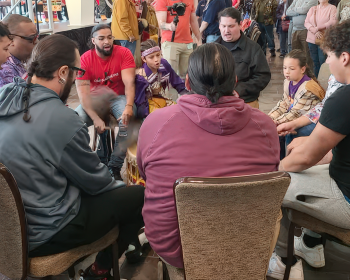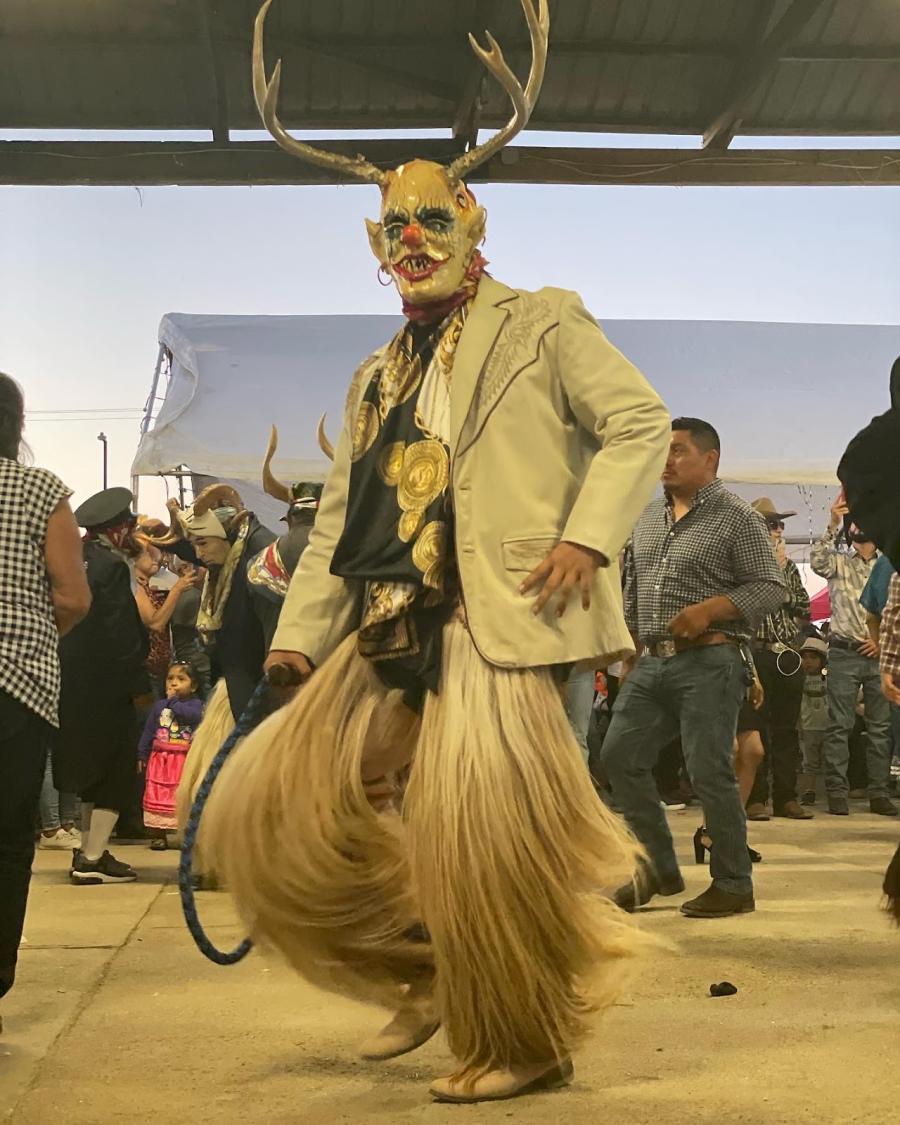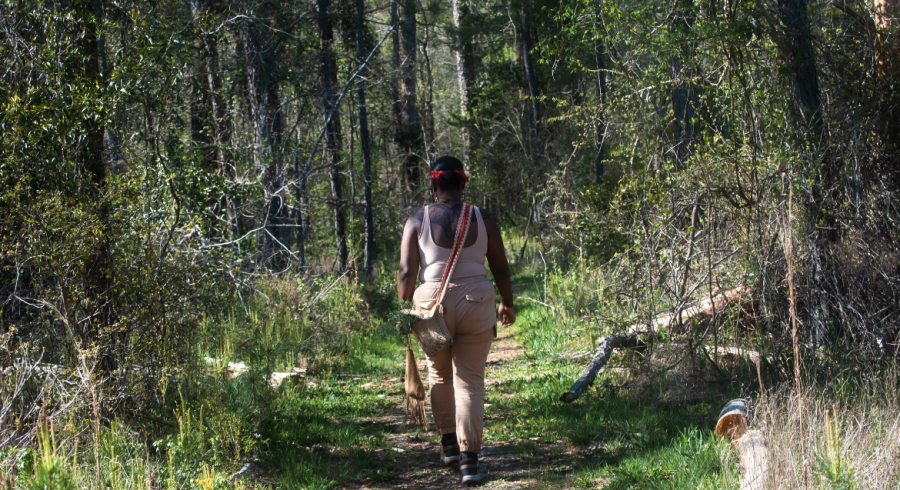With these words thundering above the roar of the river, a Tlingit elder of Southeast Alaska challenged his young followers to ponder on the significance of the waves of change surging across their homeland and revolutionizing their world. Should the listeners be able to answer his questions the elder reasoned they could find the solutions to the cultural survival of Alaska Native people.
Alaska Native people, more than at any other time in their history, are encountering distressing forces that threaten to undermine their very cultural survival. Undaunted, even after a century of battling to protect their way of life, they are looking to their own cultural traditions and values for solutions, directions, and lessons such as that offered by the Tlingit elder to point the way to their survival as a people in the new millennium.
Daanawaak, clan leader of the Lukaax.adi sponsored a Peace Ceremony in 1981 to memorialize the reconstruction of the Peace Rock. The highway department had destroyed the sacred rock as it was widening the road adjacent to the riverbank on which the rock rested. The government wanted to improve access for the thousands of tourists who were attracted by the splendors of the homeland of the Tlingit. Smiling Alaskan government officials attending the ceremony thought they were being honored for their good deed in reassembling the Peace Rock. They could not know that Daanawaak, speaking in Tlingit, had stopped the Peace Ceremony midway. He was instead chastising the officials for their continued transgressions against the Native people of Alaska. He called out to his people, "Yee gu.ayax xwaan aan yatx'u saani!" "Noble People of the Land, Take Courage!" He pleaded with them to reassert their ancient claims of ownership to their land and to fight the forces that were endangering their culture. He then called on the spirits of their ancestors and the spirits of their animal relatives to help them.
The questions asked by the elder were not answered immediately, but at the first call of the Raven in the early morning dawn as the ceremony was winding down, one of the Native participants quietly responded to the challenge:
The Tlingit elder looked directly into the respondent's eyes and acknowledged that she had in essence answered the questions correctly. However, he insisted that the waves pounding on their homeland represented "White people and their ways!" in lieu of her politically correct answer.
The elder wanted the younger Native people to reflect on the ongoing transformations and threats to their culture, and he warned them about the continued forces of change that were endangering their cultural survival. He pointed to the original Peace Rock embedded on the banks of the Chilkoot River and offered that the tenacity and strength of Native culture derived from their continuing occupation and relationship to the land and wildlife. Just as the Peace Rock had been transformed from its original form so had tribal cultures been altered from their ancient form. Like the Peace Rock which had been destroyed and then reconstructed piece by piece, the elder offered the promise that Native people can rebuild their societies on the knowledge and values of their traditional culture.
Alaska Native people were the only people who lived in Alaska at the dawning of the last millennium, and the perils they faced were limited to challenges to their physical survival. However, their relative peace was disrupted with the arrival of Euro Americans. They surged across Alaska in the waning centuries of this millennium like a powerful tide unleashing destructive forces on Alaska Native societies. For bringing civilization and Christianity, the immigrants justified the subjugation of Native people, the eradication of their languages and culture, and the colonization of Native lands.
Alaska Native people fought an aggressive battle to protect their land base and cultures. Miraculously they survived, but in the wake of the cultural encounters, their communities were left weakened with a host of both physical and social pathologies that ate away at the core of their culture. However, Native people were determined to survive.
Today Alaska Native people are drawing on their cultural values and traditions and the lessons offered by their elders and scholars, such as that of the Peace Rock, to address the continuing waves of change and forces that impact their communities. They are drawing on traditional values to guide their work such as that embedded in the Tlingit concept of Haa Shagoon which simultaneously refers to and bonds them to their ancestors and the present and future generations. They realize that their future is tied to their past. As they approach the new millennium, the 125,000 Inupiat and Yup'ik Eskimos, Aleuts, Athabaskans, Tlingit, Haida and Tsimpshian Indians living in 230 traditional villages and urban centers have united under their statewide organization, the Alaska Federation of Natives (AFN) to develop a coordinated strategy to articulate their vision of the future.
In 1994, the Alaska Native Commission, established to assess the status of Alaska Natives, released its report making a wide range of recommendations addressing the socio-economic conditions of Alaska Natives. The report outlined many of the problems Native people have faced over the generations and identified three overarching principals including, Self Reliance, Self Determination and Integrity of Native cultures which included, foremost, the rights to their subsistence hunting and fishing way of life as the key to Native survival.
Following the release of the report, the AFN embarked on a process of "visioning." They set about to bring together a synthesis of the distinct Alaska Native cultures, which had been subject to the same oppressive colonial forces, and the common goals they shared. They sponsored three studies on Alaska Native Self Governance Policy Reform, Expanding Job Opportunities for Alaska Natives, and Combating Substance Abuse and Related Violence Through Self Healing, to formulate their recommendations to the issues identified by the Alaska Native Commission.
In May 1999, the AFN together with the Inuit Circumpolar Conference, held a one-day seminar in Anchorage with international Indigenous groups to discuss self-governance and the creation of Canada's newest province (Nunavut) which they felt could serve as a model and inspiration in other countries. In August 1999, AFN sponsored an "Urban-Rural Roundtable" to discuss with urban leaders the realities of life in "bush" Alaska with a focus on subsistence hunting and fishing. In the following month, AFN and other Native American organizations sponsored a one-day "National Forum on the Future of Alaska Natives" in Washington, D.C. They met with members of Congress and other policy groups and shared with the national leaders and the media their concerns about economic development, subsistence, self-governance, and the reconciling of ancient and modern values.
In October 1999 the AFN Convention initiated its "visioning" dialogues in the Native community, to be followed by a series of regional and local meetings throughout the State. At the same time AFN adopted a strongly worded resolution which challenged the State of Alaska's assault on Native cultures and communities. The resolution outlined a series of actions initiated by the State Legislature that the Native community viewed as anti-Native and that seek to undermine Native cultures and communities. Through their action, the thousand or more Natives in attendance and representing all regions of the State proclaimed that they would initiate every political and legal means to protect themselves.
Alaska Natives, with the knowledge of their elders, the lessons of colonialism and forced but failed assimilation, are visioning their own new ideologies to control and channel the tides of change. They know that to ride the crest of the wave and survive as distinct cultures, they must strive to obtain the knowledge of a new identity and embrace appropriate changes and master the new ways. In contrast to the early historical dictatorial federal assimilative Indian policies, Native people themselves will decide their most important priorities. They alone will develop strategies to address their common problems and develop an articulated Haa Shagoon vision of their past and their own future for themselves and their children that will carry them through the next millennium.
Article copyright Cultural Survival, Inc.



